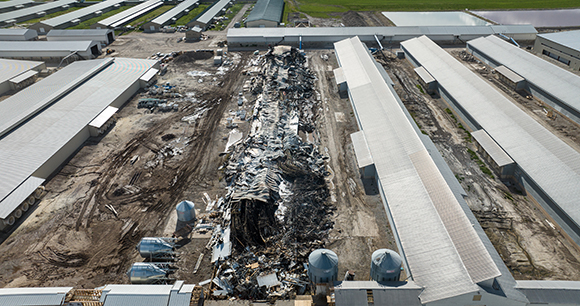
The annual death toll is the highest since 2020
Washington, DC—More than 1.5 million farmed animals perished in barn fires in 2024, accounting for 60% of the deaths reported in the last three years, according to an Animal Welfare Institute (AWI) report released today.
The report’s third edition tallies the number of animals killed in these incidents from 2022 through 2024. Last year saw the largest number of animal deaths from a single barn fire in more than a decade: 1.2 million hens in Illinois. Additionally, an exceptionally large number of cattle died in barn fires during the last three years, due primarily to a single 2022 fire at a Texas dairy operation that killed 18,000 cows. This was the deadliest reported fire involving cattle since AWI began tracking barn fires in 2013.
All told, at least 8.3 million farmed animals have died in barn fires in the last 12 years, but the real death toll could be substantially higher. Fire departments and municipalities are not required to report the number of animals killed in fires, and media reports result in an incomplete picture, demonstrating the need for more consistent reporting requirements and a centralized mechanism for tracking animal fatalities.
Compared to other animals living in confinement, farmed animals in the United States receive considerably fewer protections—they are excluded from minimum standards of care under the federal Animal Welfare Act, for instance—and there are no federal laws specifically designed to protect them from barn fires. Only five states have adopted the National Fire Protection Association’s NFPA 150, Fire and Life Safety in Animal Housing Facilities Code, a voluntary code that offers the most comprehensive level of fire protection for farmed animals while they are on farms. For the first time, under the 2025 edition of the code—which would need to be adopted by state or local jurisdictions to take effect—medium- to large-sized commercial facilities that are newly built or undergoing major construction are required to install sprinkler systems, unless exempted by a local fire authority.
No farm is immune from the devastation that a barn fire can bring; incidents range in size from several animal deaths at small, family-owned farms and backyard barns to large-scale fires at industrial facilities that kill hundreds of thousands of animals. It is clear, however that the high death toll is being driven primarily by fires occurring at massive operations housing several thousand to over 1 million animals.
At commercial egg and broiler operations, one fire can—and has—killed more animals in a single day than the number killed by all other fires combined in a year. Of the 328 barn fires reported since 2022, the 10 largest—all involving chickens—were responsible for over 90% of deaths. This is not surprising given that chickens account for around 95% of all farmed animals raised for food in the United States and, in industrial settings, are densely packed together in much higher numbers than are other farmed animal species.
“The sad reality is that hundreds of thousands of farmed animals die from fires every year, and the lack of mandated fire protection in farmed animal housing undoubtedly makes these tragic situations much worse,” said Allie Granger, policy advisor for AWI’s Farmed Animal Program, who authored the report. “The death toll will likely continue to rise unless this problem is addressed by the country’s largest poultry and livestock farms, where millions of animals remain at risk.”
As in previous years, barn fires during the most recent three-year period most often occurred in the Upper Midwest and Northeast during winter months—suggesting that colder weather is a significant factor in the prevalence of barn fires. New York and Wisconsin recorded the most barn fires (31 each), followed by Pennsylvania (28), Ohio (23) and Illinois (22).
In many instances, the destruction from a barn fire is too severe to determine an actual cause. In the vast majority of cases in which a report indicated a suspected or determined cause, improper use of or a malfunctioning heating device or another electrical malfunction was cited, according to AWI’s research.
Many fires could be prevented or their impacts mitigated with proper inspection, maintenance, and detection/suppression systems, the report concludes.
“Trapped by the thousands inside burning enclosures, farmed animals endure unimaginable suffering,” Granger said. “It is the responsibility of state and local authorities, as well as farmers and industry groups, to require and implement stronger fire protection standards on farms to help animals avoid this terrible fate.”
Marjorie Fishman, Animal Welfare Institute
[email protected], (202) 446-2128
The Animal Welfare Institute (awionline.org) is a nonprofit charitable organization founded in 1951 and dedicated to alleviating animal suffering caused by people. We seek to improve the welfare of animals everywhere: in agriculture, in commerce, in our homes and communities, in research, and in the wild. Follow us on Facebook, X (formerly Twitter), and Instagram for updates and other important animal protection news.